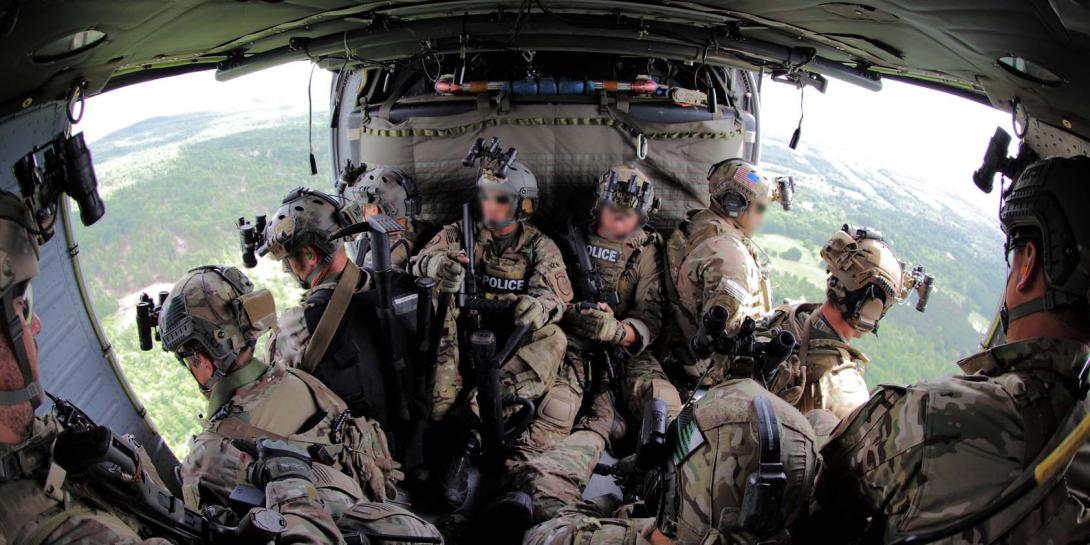Homegrown Violent Extremists Top Homeland Threat List
The greatest threat facing the U.S. homeland mixes both internal and external enemies, according to the Department of Homeland Security's undersecretary for intelligence and analysis. Homegrown violent extremists influenced by overseas radical ideologues top the list of hazards confronting the public and private sectors in their efforts to secure the country.
Many overseas terrorist organizations still see the United States as the enemy and a roadblock to achieving their objectives. But the threat within now grabs the lion’s share of attention from the Department of Homeland Security (DHS) as well as from intelligence and law enforcement groups that strive to stay a step ahead of terrorists.
Francis X. Taylor, the DHS undersecretary for intelligence and analysis, relates that many of these homegrown threats are inspired or directed by al-Qaida or the Islamic State of Iraq and the Levant (ISIL). Describing homegrown extremists as “the most immediate threat,” he notes that small-scale attacks by U.S.-based radicals already have taken place, in addition to the large-scale attacks in Paris and Brussels by terrorists based in those cities. To one extent or another, all these terrorists were influenced by the writings of overseas Islamic violent extremists.
Taylor offers that the traditional al-Qaida model of training people to enter the United States and commit acts of terrorism is harder to do today. Instead, social media and other network links are empowering outside groups to reach into the United States and find potential activists who are susceptible to their violence-inspired doctrines. Given the number of people attempting to fight overseas for ISIL who have been arrested by the FBI, radical propaganda is penetrating the United States, and it is working. The FBI is investigating many hundreds of potential terrorists in all 50 states, he adds.
“ISIL is probably one of the most brutal organizations we have ever witnessed in our fight against terrorism,” Taylor states. “That brutality and viciousness has resonated in the hearts and minds of young men around the globe to draw them into the fight. This is a determined enemy who has figured out a way to recruit men and women to its cause with great effectiveness. We cannot underestimate that ability.
“We will defeat them,” Taylor declares. “But how we do it and how long it takes is challenging.”
At the same time, the other threats the DHS has confronted over more than a decade have not disappeared. Terrorists still want to bring down passenger aircraft, which has happened overseas at least twice over the past few months. “When we think of counterterrorism and threats to the homeland, we think about aviation security and ensuring the safety and security of Americans traveling on U.S. aviation globally,” Taylor observes.
Border security is another traditional challenge that continues to vex security planners. The DHS must ensure that potential terrorists or foreigners seeking to harm the U.S. public do not exploit border access to enter the United States, Taylor notes.
The department also must guard against attacks on the nation’s infrastructure. Critical services such as gas, water and power remain targets for all manner of malefactors striving to damage the United States. “We are so computer-driven in this country that much of our critical infrastructure runs on cyber networks, and we have to make sure they are hardened and there are no back doors to potentially disrupt electrical, water or other services that are driven by computer systems,” Taylor states.
Cyberspace endures as an arena of operation for criminals and nation-states attempting to weaken domestic security. Adversaries have steadily become more adept over the years, Taylor points out, especially at penetrating the world’s cyber systems. Criminals generally are profit-driven, while nation-states seek to steal trade secrets that could be used to gain an illicit economic edge that undermines the United States, he notes.
ISIL is using social media extensively to communicate with and recruit potential terrorists. This represents a significant change from al-Qaida’s use of the Internet, Taylor says. ISIL has “one of the most sophisticated ‘marketing’ strategies to do outreach in many different ways to many different constituencies that are important … for support for the caliphate and its objectives in Syria and Iraq,” he states.
The march of cyber technology that has fueled U.S. economic and military strength over the past two decades is empowering adversaries, Taylor says. And, in many cases, it has benefitted terrorists to a greater degree than the United States. The ability to listen to terrorist chatter, which was a key element of U.S. intelligence gathering, is becoming much harder with point-to-point encryption. New smartphone software also is making it more difficult for legitimate law enforcement operations to access conversations by terrorists as they plot attacks, he states.
To combat cyberthreats, the DHS is working to comprehend intrusion sets and how adversaries are trying to exploit computer systems illegally. Understanding and blocking signatures and malware is the purview of the department’s National Cybersecurity and Communications Integration Center, or NCCIC. This single site dedicated to grasping risks to the .gov network provides an advantage for both the government and the private sector and is an important breakthrough for U.S. and overseas security bodies, Taylor states.
“We have a thinking, evolving enemy,” he declares. “This enemy is evolving in tactics, techniques and procedures to try to circumvent the security procedures we have put into place, and we have to be ever vigilant to stay ahead of the enemy—not looking back, but looking forward to what that enemy may try to do to us.”
The department has not changed its homeland security approach as a result of the March Brussels attacks, Taylor emphasizes. The DHS was concentrating on counterterrorism before the killings in France and Belgium, as it has been virtually since its founding. What has changed is the intensity of its focus on cooperation, he says.
One DHS strategy is “to play offense on the enemy’s 1-yard line, as opposed to playing defense on our 1-yard line,” Taylor says. This outreach to international partners aims to enhance information exchanges about terrorist threats and individuals so nations can understand better how their organizations are operating globally.
He notes that this strategy was in place before the Brussels bombings, and it continues to evolve. “Brussels was a wake-up call for many of our colleagues in Europe in terms of the power of exchanging information in a continuous and open fashion, both in Europe and around the globe,” Taylor posits. The European migration crisis has unveiled challenges to coordination and information sharing among partners that can contribute to a “risk gap,” resulting in the type of attacks that hit Brussels and Paris.
“We learned a huge lesson in our own country, after 9/11, on the power of collaboration and information exchange,” Taylor allows. “Since that time, we have worked with our partners around the globe to improve and enhance that information exchange because it is never perfect. It is never where it needs to be—it can always be better.
“Our efforts, along with those of our colleagues around the globe, are to improve not only the amount of information but also the effectiveness of that information exchange ... in a manner that protects the privacy and civil rights of our citizens: the tenets of democracy around the globe,” he declares. At the heart of this activity, all sides must understand each other’s information needs and build systems that allow information to be exchanged “in a more systematic way” as opposed to individual reports, Taylor offers.
Domestically, government organizations do not encounter barriers to exchanging security-related information with each other, he says. Both the executive and legislative branches have given full support to effective information exchange for counterterrorism. The quality and intensity of that exchange have improved substantially since September 11, 2001, especially among the cultures that define each organization. Institutional leadership no longer embraces the organizational tribalism that has its origins in human nature. “That is the most impressive thing that has changed,” Taylor declares.
One change he still would like to see is a shift in the world view that internal measures alone ensure homeland safety. “You can’t play border security within the confines of your homeland and think you’re safe,” Taylor says. “That’s not the world we live in. People can move from one side of the world to the other in hours, and information can move in nanoseconds.
“Understanding the global phenomenon and how it may manifest itself requires a level of information sophistication that we do not have yet—but we’re moving in that direction,” he states.
The next big technology the DHS will be relying on is big data analytics, Taylor offers. It will be useful for uncovering patterns of behavior that otherwise would not be discovered without comparing large amounts of data. Understanding how people move and where they are moving can help reveal hallmarks of adversarial behavior from one country to another. The DHS is conducting these kinds of analyses now, but improving the process would constitute “the biggest breakthrough that we need to continue to strive toward,” he says.
Also high on the DHS wish list are new tools for gaining knowledge from everyday operations, Taylor adds. For example, the department is beginning to review social media for people applying for visas and refugee benefits. This involves millions of people, and the DHS needs tools for searching across their open source data. Industry already has offered many good ideas, and the department seeks to build on them, he notes.
The DHS is looking not only to U.S. companies for solutions to its challenges but also worldwide for the best technology, Taylor emphasizes. Some foreign solutions may find their way to the department via U.S. firms that are familiar with the good ideas developed overseas. “Good ideas will find their way to the right pocket,” he warrants.
Securing the homeland is a team sport, Taylor emphasizes, adding, “Everybody has to be on the field playing their ‘A’ game.” This entails working in concert at the federal, state and local levels as well as in the private sector, where 85 percent of the nation’s critical infrastructure resides. The thinking, evolving enemy makes it more important than ever that vital information moves on a daily basis “into the hands of people who can do something with it in a consistent, effective manner,” he states.
Fusion centers, for example, move DHS information to police on the street. Taylor is haunted by the fact that local police in 2001 pulled over at least one of the future 9/11 hijackers for a moving violation. Not knowing the potential threat they were dealing with, the police released them. “We’re not perfect, but that wouldn’t be the case today if they were known as suspected terrorists,” Taylor declares.
For more on this topic, AFCEA is hosting the 2016 Homeland Security Conference June 21-22 in Washington, D.C., exploring the theme of "Securing the Nation—Solving Technology and Human Capital Challenges: People, Partners, Priorities."






Comments